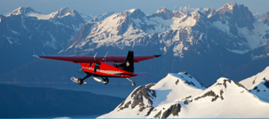Mountain Flying
Well, spring trying to peak through the final days of winter, which means better flying weather! As pilots, flying in the Pacific Northwest affords us the opportunity to see some of the most beautiful scenery in the world due to the dynamic physical geography of this region! A “short hop” in a general aviation airplane can take us from the Pacific Ocean, across the Olympic coastal mountain range, over the Puget Sound, and into the Cascade mountain range.
On a flight like this, you can see beaches stretching for miles and interesting rock outcroppings jutting out of the ocean. You can see the Hoh rain forest of the Olympics along with its snow-covered peaks and glacier fields. You may even see whales in the Puget Sound, and possibly mountain goats making their way along the rugged terrain of the Cascades. As pilots, we get to experience this region’s geography in a way that most people do not.
Although this type of “mountain flying” has many rewards, it also introduces many flight risks. “Risk mitigation” is something that we as pilots consider and address as part of our flight planning. Mountainous terrain has a great effect on wind and weather patterns that pilots need to be aware of. In many cases, we may also be flying at higher altitudes that push the limits of aircraft performance, and if an emergency or precautionary landing is needed, there are typically few options. Although this is only a short list of mountain flying risks, the risk can be reduced significantly with proper planning and preparation.
Mountain Flying Training
Consider taking a mountain flying course this year. Your instructor should be experienced in mountain flying, especially in the Pacific Northwest. Having a flight school say, “we’ll take you for a flight into the mountains,” is not a mountain flying course. Nor is watching a video, as each region is different. A good ground school course on the topic can last 1-2 hours, and may (should) include a flight in mountainous terrain, so you can experience and test the performance limits of your aircraft, route selection, landing options, etc.
Safety in Motion Flight Center routinely offers mountain flying clinics and in-flight training. Much of this training can be credited toward training requirements for Private and Commercial certificates while experiencing a fun and educational day of flying!
Learn more about our Flight Courses!
So consider taking this time of weather transition to attend a mountain flying course to learn more about the subject! If you plan to visit airports in or close to mountainous terrain, schedule mountain flight training with a reputable school/instructor to gain experience. Your investment of time and money into learning about mountain flight will definitely pay off as you will be able to operate safely in and around the awesome terrain we are lucky to have in our “backyard!”
Shawn Pratt is the Director of Operations and Chief Flight Instructor at Safety in Motion Flight Center. He has flown coast to coast a few times through the Blue Ridge Mountains, Rockies, Sierras, Cascade, and Olympic mountain ranges, and being from Sitka Alaska has flown throughout that region as well. You can typically find him teaching mountain clinics at aviation events around the region, online, and at the Flight Center.
Contact Us Today to Learn More!



